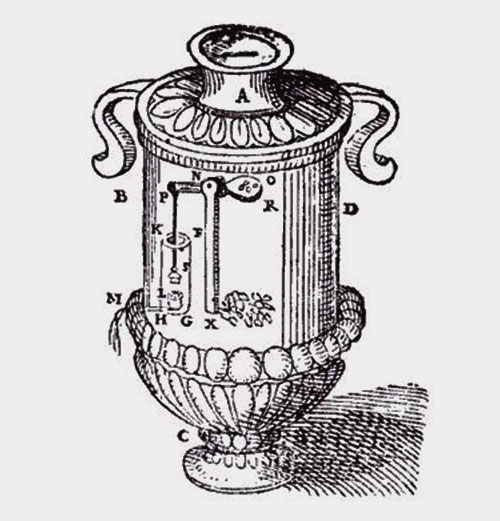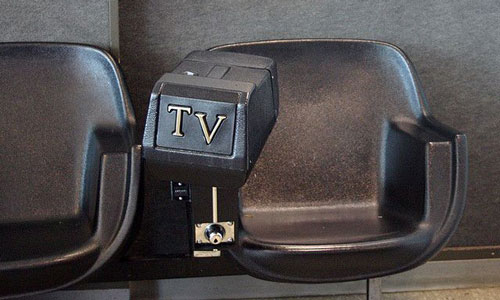Today in Tedium: Vending machines are one of the few things keeping us away from the dream of a cashless society. The devices, which offer up an array of items for a little bit of pocket change, are silent but prevalent. They represent some of our most technologically advanced furniture, and they'll probably always be there for us in our time of need. Today's Tedium discusses their history—along with why, for some reason, they make us want to steal stuff. — Ernie @ Tedium

The first vending machine was created to prevent holy water theft
Heron of Alexandria invented a lot of things, many of which helped set the stage for our modern society. Steam engine? He was all over it. A wind-powered machine? That was him. The syringe? He got there first.
But perhaps the most interesting thing he invented during his lifetime was a machine that efficiently ensured that people weren't taking too much holy water at the temples where they went to worship. It was an annoying, frustrating problem, but Heron came up with a solution that was immensely clever.
Basically, people would drop tokens inside of the holy water dispenser, and the weight of the token would push against a lever that opened a small door. While the door was open, the holy water would fall out. Eventually, however, the coin would fall and the door would close—ensuring that people never took more than their fair share of holy water.
The craziest part? Modern society didn't really embrace his invention for about 1,800 years. Heron died around 70 A.D.; it wasn't until 1883, when inventor Percival Everett created a vending machine for postcards and notepaper, that Heron's idea proved to have a lasting impact.
Granted, we use it for Cool American Doritos these days rather than holy water, but the mechanisms are fairly similar—money goes in, gears turn, stuff comes out. Everything should be this simple.
$3.4k
The amount it'll cost you to buy a standard vending machine on Amazon. If you charge $1.25 for each item, pay 75 cents wholesale for each item inside, and sell twenty items per week from your vending machine, you'll make your money back in about six and a half years. That hasn't, however, stopped the vending machine industry from earning more than $20 billion in revenue each year.

Saw you and me on the coin-op TV
Vending machines have traditionally been associated with just a few types of products—basically, food and drink. However, the basic mechanisms that drive vending are pretty common in other products, such as laundry machines, arcade games, and jukeboxes.
Perhaps the weirdest such use of the coin-operated mechanism, however, is the coin-operated television. Popular in the 1960s and the 1970s, the devices allowed people to pay a quarter to watch half an hour of local television, a respite that certainly came in handy during periods where you were basically stuck somewhere for a long time—think bus stations, airports, and laundromats.
The most well-known brand for coin-op televisions was the Tel-A-Chair, which was prominent at LAX. A 1970 Parade magazine article, recently resurfaced by Retrospace, highlights the fact that the chairs were moneymakers for both the company and the airport.
"It costs us $350 to manufacture a chair," creator John W. Rich noted. "And we give the airports and bus stations 35 percent of the revenue for the location. We've had requests from dozens of airports, rail-roads, bus stations, and beauty parlors. Wherever people wait, the Tel-A-Chair is a natural."
It was a good idea, though one with a limited time frame. Within two decades, laptops and Game Boys became popular time-wasters. Within four decades, everyone had smartphones, WiFi, and Netflix to kill our wasted time. Who needs a coin-operated TV when you have Siri in your pocket?
Arcade machines can be put into the same category as coin-op TVs when you think about it. When's the last time you walked into an arcade that wasn't owned by Dave or Buster? Stuff is easier to vend than experiences are.
119
The number of ridges that one can find on an American quarter. Ridges came about as a fraud-prevention device, and most vending machines can recognize those ridges. Vending machines are generally smart enough to figure out the relative dimensions of a quarter, a dime, and a nickel—and the number of ridges are an important part of that equation as they help give the coins their basic shape. Despite being significantly smaller than quarters, by the way, dimes have 118 ridges, just one less than their higher-in-value cousins.
Five methods that vending machines have used to verify dollar bills
- Magnetic tape heads: Much like your 8-tracks of lore, early dollar-eating vending machines relied on a tape-head-style mechanism to detect whether a dollar had the correct amount of iron content that a dollar does. This eventually proved easy to defeat, because laser printers created output with similar amounts of iron-laced ink.
- Optical sensors: Starting in the early 1990s, vending machines switched to using what could best be described as low-resolution digital cameras to verify a dollar bill's validity. The device would look for specific patterns in the dollar, and if they didn't work, they didn't accept your dollar. That's why your crumpled-up bill never works.
- Size analysis: All U.S. dollar bills made in the last 85 years or so have roughly the same dimensions, and as a result, a dollar-scanning machine can figure out whether a bill is the right weight, thickness, and size to be accepted by the machine.
- Infrared detection: Most modern dollar bills have a strip of infrared tape baked into the bill. This strip is detected by the machine, making it easy to figure out whether a bill is real or fake. Often, counterfeiters will take lower-denomination bills, turn them into $20s or $100s, and pass those off as the real deal. Unfortunately for them, the infrared strip doesn't lie.
- Ultraviolet lights: That $20 in your pocket has a tiny little strip of mylar woven through. Not that you'd ever see it by just looking at it—you need an ultraviolet light to detect its fluorescence. That just happens to be something a dollar-scanner has.
"Let's not kid ourselves here. We're not trying to get into these things for the aesthetic value of the job. We want the stuff inside."
— A 2001 document discussing the nature of breaking into a vending machine using methods such as saltwater, clay, and using laminated dollars. The document, which is probably grossly out of date and full of advice dating back to the BBS era, features this perfectly useless warning that would never hold up in a court of law: "I do not in any way promote any illegal activity in this file all information provided here is purely for informational purposes. So if you get caught, don’t come whining to me."
When I was in college, there was a vending machine in my dorm that had a somewhat infamous reputation. The machine, which offered up beverages such as Starbucks Frappuccinos and various juices, was poorly designed. How poor? Well, people could easily put their arms into the bottom and reach through, allowing them to grab beverages on the bottom row with no problem.
It was so effective that the bottom row was pretty much always empty.
But the memory that stands out most about this specific vending machine involved the time that, in the middle of the night, a muscular dude who lived on my floor decided it would be a great idea to lift up the vending machine to see what would come out. Sound superhuman? It probably was. But the guy did it, and after the machine thudded back down three or four inches, it was a jackpot. Every single drink in the machine hit the bottom.
It was a victory for poor college students everywhere.




